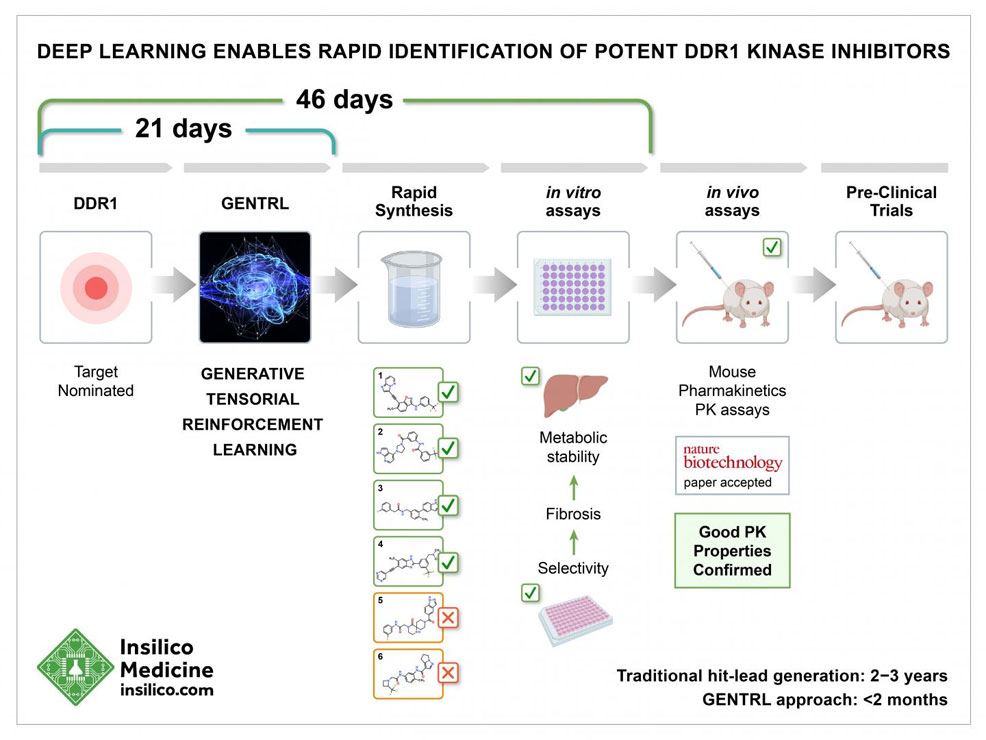
7th September 2019 AI creates new drug compounds in just 21 days Insilico Medicine reports the creation – via artificial intelligence – of six new drug compounds in just 21 days, with a lead candidate tested and showing positive results in mice.
Traditional drug discovery starts with testing thousands of small molecules, which are narrowed down to just a few candidates – and only about 1 in 10 of these will ultimately pass clinical trials in human patients. Even a slight improvement in the time it takes to discover new drugs, or a slight improvement in the probability of their success, can result in significant savings down the line in terms of money and research effort. Insilico Medicine, headquartered in Hong Kong, has been collaborating with biopharmaceutical firms to develop next-generation deep learning approaches for every step of the drug discovery and drug development process. Since 2015, the company has been developing a broad range of generative adversarial networks (GANs) and reinforcement learning approaches to identify novel protein targets, generate novel molecular structures with specified properties and generate synthetic data. This includes programs in a range of cancers, fibrosis, central nervous system diseases, sarcopenia, metabolic diseases, dermatological diseases, and senescence. The company's latest research, published this week in Nature Biotechnology, describes a timed challenge, where a new artificial intelligence system called Generative Tensorial Reinforcement Learning (GENTRL) designed six novel inhibitors of DDR1 – a kinase target, implicated in fibrosis (thickening and scarring of connective tissue) and other diseases. Four of the compounds were active in biochemical assays, and two were validated in cell-based assays. One lead candidate was tested and demonstrated favourable pharmacokinetics in mice. Based on a reinforcement learning system with rewards, GENTRL produced 30,000 molecular structures, which were then filtered and prioritised according to a number of criteria. GENTRL was able to design these new compounds in just 21 days. The entire process – from initial nomination of the DDR1 target, through to in vivo assays – took only 46 days. For comparison, traditional hit-lead generation typically requires two to three years.
"This paper is certainly a really impressive advance and likely to be applicable to many other problems in drug-design," said Dr. Michael Levitt, Professor of Structural Biology at Stanford University. Levitt received the Nobel Prize in Chemistry in 2013. "Based on state-of-the-art reinforcement learning, I am also very impressed by the breadth of this study, involving as it does molecular modelling, affinity measurements, and animal studies." "I interacted with many AI startups in the past and Insilico was the only deep learning company with impressive, demonstrated capabilities integrating target identification and small molecule discovery," said Dr. John Baldoni, CTO of a stealth startup working on AI-powered drug development and a former SVP of Platform Technology and Science at GSK. "They did a lot of theoretical work in GANs from the very beginning and this experimental validation is a significant demonstration that this technology may improve and accelerate drug discovery." "Much hyperbole exists about the promise of artificial intelligence (AI) in improving medical care and in the development of new medical tools. Here however is a paper in Nature Biotechnology that describes an application of AI in drug discovery that is indeed important. A new drug candidate was proposed and tested preclinically in a remarkably short period of time," said Dr. Charles Cantor, former Chief Scientist of the Human Genome Project. "The results are significant for two reasons. The AI procedures replaced the role normally played by medicinal chemists, and these individuals are in limited supply. The acceleration in rate translates into longer patent coverage that improves the economics of drug development. If this approach can be generalised, it could become a widely adopted method in the pharmaceutical industry." "This paper is a significant milestone in our journey towards AI-driven drug discovery," said Alex Zhavoronkov, PhD, founder and CEO of Insilico Medicine and the lead author of this study. "We work in generative chemistry since 2015 and when Insilico's and Alán's theoretical papers were published in 2016, everyone was very skeptical. Now, this technology is going mainstream and we are happy to see the models developed a few years ago and producing molecules against simpler targets being validated experimentally in animals. When integrated into comprehensive drug discovery pipelines, these models work for many target classes and we work with the leading biotechnology companies to push the limits of generative chemistry and generative biology even further." In 2017, NVIDIA selected Insilico Medicine as one of the Top 5 AI companies in its potential for social impact. In 2018, the company was named as one of the global top 100 AI companies by CB Insights and received the Frost & Sullivan 2018 North American Technology Innovation Award for AI in aging research and drug development.
Comments »
If you enjoyed this article, please consider sharing it:
|








